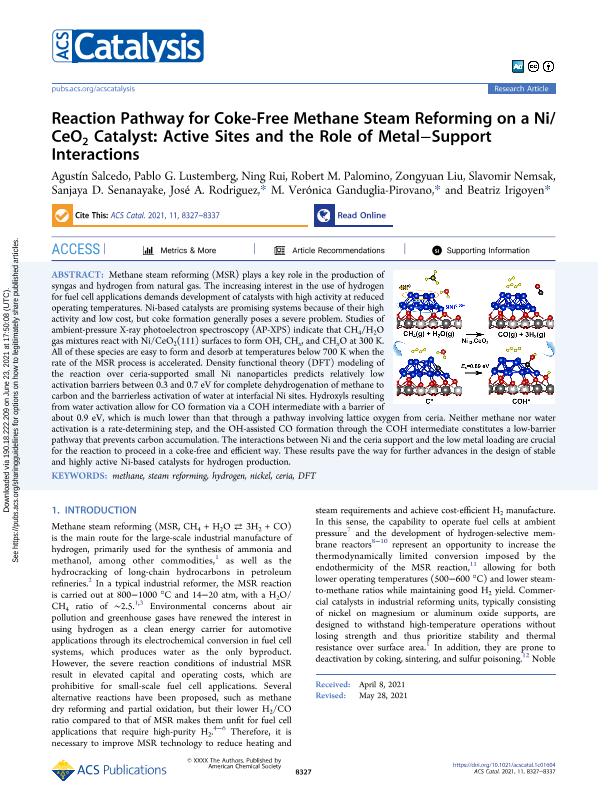Mostrar el registro sencillo del ítem
dc.contributor.author
Salcedo, Agustín

dc.contributor.author
Lustemberg, Pablo German

dc.contributor.author
Rui, Ning
dc.contributor.author
Palomino, Robert M.
dc.contributor.author
Liu, Zongyuan
dc.contributor.author
Nemsak, Slavomir
dc.contributor.author
Senanayake, Sanjaya D.
dc.contributor.author
Rodriguez, José A.
dc.contributor.author
Ganduglia Pirovano, M. Verónica
dc.contributor.author
Irigoyen, Beatriz del Luján

dc.date.available
2023-09-19T17:45:12Z
dc.date.issued
2021-06
dc.identifier.citation
Salcedo, Agustín; Lustemberg, Pablo German; Rui, Ning; Palomino, Robert M.; Liu, Zongyuan; et al.; Reaction Pathway for Coke-free methane steam reforming on a Ni/ CeO2Catalyst: Active Sites and the Role of Metal-Support Interactions; American Chemical Society; ACS Catalysis; 11; 13; 6-2021; 8327-8337
dc.identifier.issn
2155-5435
dc.identifier.uri
http://hdl.handle.net/11336/212157
dc.description.abstract
Methane steam reforming (MSR) plays a key role in the production of syngas and hydrogen from natural gas. The increasing interest in the use of hydrogen for fuel cell applications demands development of catalysts with high activity at reduced operating temperatures. Ni-based catalysts are promising systems because of their high activity and low cost, but coke formation generally poses a severe problem. Studies of ambient-pressure X-ray photoelectron spectroscopy (AP-XPS) indicate that CH4/H2O gas mixtures react with Ni/CeO2(111) surfaces to form OH, CHx, and CHxO at 300 K. All of these species are easy to form and desorb at temperatures below 700 K when the rate of the MSR process is accelerated. Density functional theory (DFT) modeling of the reaction over ceria-supported small Ni nanoparticles predicts relatively low activation barriers between 0.3 and 0.7 eV for complete dehydrogenation of methane to carbon and the barrierless activation of water at interfacial Ni sites. Hydroxyls resulting from water activation allow for CO formation via a COH intermediate with a barrier of about 0.9 eV, which is much lower than that through a pathway involving lattice oxygen from ceria. Neither methane nor water activation is a rate-determining step, and the OH-assisted CO formation through the COH intermediate constitutes a low-barrier pathway that prevents carbon accumulation. The interactions between Ni and the ceria support and the low metal loading are crucial for the reaction to proceed in a coke-free and efficient way. These results pave the way for further advances in the design of stable and highly active Ni-based catalysts for hydrogen production.
dc.format
application/pdf
dc.language.iso
eng
dc.publisher
American Chemical Society

dc.rights
info:eu-repo/semantics/openAccess
dc.rights.uri
https://creativecommons.org/licenses/by/2.5/ar/
dc.subject
CERIA
dc.subject
DFT
dc.subject
HYDROGEN
dc.subject
METHANE
dc.subject
NICKEL
dc.subject
STEAM REFORMING
dc.subject.classification
Otras Ciencias Químicas

dc.subject.classification
Ciencias Químicas

dc.subject.classification
CIENCIAS NATURALES Y EXACTAS

dc.title
Reaction Pathway for Coke-free methane steam reforming on a Ni/ CeO2Catalyst: Active Sites and the Role of Metal-Support Interactions
dc.type
info:eu-repo/semantics/article
dc.type
info:ar-repo/semantics/artículo
dc.type
info:eu-repo/semantics/publishedVersion
dc.date.updated
2023-09-18T13:29:57Z
dc.journal.volume
11
dc.journal.number
13
dc.journal.pagination
8327-8337
dc.journal.pais
Estados Unidos

dc.journal.ciudad
Maryland
dc.description.fil
Fil: Salcedo, Agustín. Consejo Nacional de Investigaciones Científicas y Técnicas. Oficina de Coordinación Administrativa Ciudad Universitaria. Instituto de Tecnologías del Hidrogeno y Energias Sostenibles. Universidad de Buenos Aires. Facultad de Ingeniería. Instituto de Tecnologías del Hidrogeno y Energias Sostenibles; Argentina. Universidad de Buenos Aires. Facultad de Ingeniería. Departamento de Ingeniería Química; Argentina
dc.description.fil
Fil: Lustemberg, Pablo German. Consejo Nacional de Investigaciones Científicas y Técnicas. Centro Científico Tecnológico Conicet - Rosario. Instituto de Física de Rosario. Universidad Nacional de Rosario. Instituto de Física de Rosario; Argentina. Consejo Superior de Investigaciones Científicas; España
dc.description.fil
Fil: Rui, Ning. Brookhaven National Laboratory; Estados Unidos
dc.description.fil
Fil: Palomino, Robert M.. Brookhaven National Laboratory; Estados Unidos
dc.description.fil
Fil: Liu, Zongyuan. Brookhaven National Laboratory; Estados Unidos
dc.description.fil
Fil: Nemsak, Slavomir. Lawrence Berkeley National Laboratory; Estados Unidos
dc.description.fil
Fil: Senanayake, Sanjaya D.. Brookhaven National Laboratory; Estados Unidos
dc.description.fil
Fil: Rodriguez, José A.. Brookhaven National Laboratory; Estados Unidos
dc.description.fil
Fil: Ganduglia Pirovano, M. Verónica. Consejo Superior de Investigaciones Científicas; España
dc.description.fil
Fil: Irigoyen, Beatriz del Luján. Consejo Nacional de Investigaciones Científicas y Técnicas. Oficina de Coordinación Administrativa Ciudad Universitaria. Instituto de Tecnologías del Hidrogeno y Energias Sostenibles. Universidad de Buenos Aires. Facultad de Ingeniería. Instituto de Tecnologías del Hidrogeno y Energias Sostenibles; Argentina. Universidad de Buenos Aires. Facultad de Ingeniería. Departamento de Ingeniería Química; Argentina
dc.journal.title
ACS Catalysis
dc.relation.alternativeid
info:eu-repo/semantics/altIdentifier/url/https://pubs.acs.org/doi/10.1021/acscatal.1c01604
dc.relation.alternativeid
info:eu-repo/semantics/altIdentifier/doi/https://doi.org/10.1021/acscatal.1c01604
Archivos asociados
